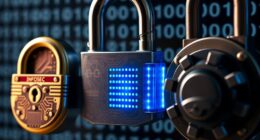The security measures in iPads, including the robust iOS architecture, compartmentalized app structure, stringent security protocols, regular software updates, and data encryption, work together to safeguard against potential hacking threats. By managing app permissions, setting up secure passcodes, utilizing features like Find My iPhone, and implementing additional security measures such as Apple Configurator 2 options and mobile security programs, iPad users can bolster their device's security stance and protect against unauthorized access. These strategies create a strong defense against hackers and guarantee that sensitive information remains secure. Further details on enhancing iPad security are available in the provided research.
Key Takeaways
- Robust iOS architecture and security protocols deter hackers.
- Regular software updates patch vulnerabilities to enhance security.
- Data encryption on iPad prevents unauthorized access to sensitive information.
- App permissions and privacy controls reduce the risk of breaches.
- Strong passcode protection and Find My iPhone feature enhance device security.
Ipad Security Measures
When considering iPad security measures, users can rely on the robust architecture of iOS and compartmentalized app structure to mitigate potential hacking risks. The iOS operating system, known for its stringent security protocols, helps in safeguarding iPads against malware and unauthorized access by hackers.
The compartmentalization of apps further enhances security by containing any potential malware within a single app, preventing it from spreading throughout the device.
To bolster security on iPads, users are advised to follow best practices such as regularly updating the device's software, refraining from jailbreaking, using strong and unique passwords, and exercising caution when dealing with suspicious emails and websites.
Additionally, enabling features like Find My iPad can provide an added layer of security by allowing users to track and remotely wipe their device in case of theft or loss.
Importance of Software Updates

Considering the critical role software updates play in enhancing iPad security, it is imperative for users to prioritize regularly updating their devices to mitigate potential hacking risks.
Apple releases frequent software updates specifically designed to address security vulnerabilities that hackers could exploit to gain unauthorized access to sensitive information.
Delaying these updates greatly increases the likelihood of falling victim to cyber threats, as hackers often target devices with outdated software.
By keeping iPads updated with the latest releases, users can proactively enhance their protection against malicious hacking attempts.
It is essential to understand that these updates are not merely about adding new features but are primarily focused on strengthening the device's security posture.
Hence, staying current with software updates is a fundamental step in safeguarding the integrity of personal data stored on iPads and ensuring a more secure digital experience.
Encryption Options for Backups

When contemplating the security of your iPad data, encryption options for backups play an essential role.
By encrypting your backups with a password, you establish a secure method to safeguard your sensitive information from unauthorized access.
This additional layer of security guarantees that even if the backup file falls into the wrong hands, your data remains protected.
Backup Encryption Importance
Utilizing encryption for iPad backups is a fundamental step in safeguarding sensitive data against potential breaches by hackers seeking unauthorized access.
By encrypting iPad backups using tools like iTunes or Finder, an additional layer of security is added to prevent unauthorized individuals from accessing personal information.
Encrypted backups necessitate a password for data retrieval, greatly reducing the risk of sensitive data falling into the wrong hands.
Without encryption, hackers could exploit vulnerabilities to gain access to personal data stored within iPad backups, compromising data security and privacy.
Therefore, selecting encryption options for iPad backups plays a pivotal role in enhancing overall data security measures.
It is imperative for users to prioritize backup encryption to mitigate the risks associated with unauthorized access and ensure the protection of sensitive information stored on their devices.
Secure Backup Methods
To enhance data security and protect sensitive information stored on iPads, exploring secure backup methods such as encryption options is essential.
Encrypting iPad backups provides an additional layer of protection against unauthorized access to personal data, passwords, and other sensitive information. When utilizing iTunes or Finder on a computer to create backups, iOS offers the option to encrypt the data, ensuring that even if the backup falls into the wrong hands, the information remains secure.
Encryption plays an important role in data security by scrambling the data in such a way that it can only be accessed with the decryption key, thereby safeguarding against potential breaches.
Regularly creating encrypted backups is highly recommended to mitigate the risks associated with device loss or security breaches, as it helps maintain the confidentiality and integrity of important information.
Customizing App Permissions

Customizing app permissions on your iPad is essential for enhancing security and protecting your sensitive data. By carefully managing which apps have access to features like location and camera, you can reduce the risk of potential data breaches.
Regularly reviewing and updating app permissions will help guarantee that your iPad remains secure from unauthorized access to your personal information.
App Permissions Overview
Users have the ability to modify app permissions on their iPads through the Privacy menu in Settings. By customizing app permissions, users can control which apps have access to sensitive features such as location, microphone, and camera. This level of control enhances data security and privacy on the iPad, ensuring that personal information is safeguarded.
It is important to regularly review and adjust these permissions to restrict unnecessary access and prevent potential breaches of sensitive data.
Enhanced Privacy: Customizing app permissions allows users to have greater control over their privacy settings, ensuring that only trusted apps have access to sensitive features.
Data Security: By restricting app permissions to essential functions only, users can protect their personal information from being accessed or misused.
Preventing Unauthorized Access: Regularly checking and adjusting app permissions can help prevent unauthorized access to sensitive data, reducing the risk of privacy breaches.
Security Settings Guide
Enhancing the security of your iPad involves strategically managing app permissions within the Settings menu, particularly focusing on customizing access to sensitive data. By navigating to the Privacy menu, users can review and tailor app permissions to restrict access to functions like location, microphone, camera, and Health data. This customization helps limit access to personal information, thereby enhancing the overall security of the device and protecting against potential data breaches. Restricting app permissions for specific features ensures that only trusted applications have access to necessary data, minimizing the risk of unauthorized access to sensitive information. By carefully controlling app permissions, users can safeguard their personal data and use their iPad with increased peace of mind.
| App Permissions | Privacy Menu | Enhance Security |
|---|---|---|
| Customize access | Review permissions | Limit data access |
| Restrict functions | Tailor permissions | Protect personal info |
| Manage sensitive data | Prevent unauthorized access | Minimize data breaches |
Setting Up Secure Passcode

For heightened security measures on your iPad, it is crucial to set up a strong and unique passcode to safeguard against unauthorized access. To guarantee the highest level of protection, consider the following steps:
- Use a strong passcode: Opt for a custom alphanumeric passcode rather than a simple numerical one. This adds an extra layer of security by incorporating letters, numbers, and special characters.
- Enable the self-wipe feature: Activate this function to protect your data in case of multiple unsuccessful passcode attempts. The self-wipe feature will erase all information on your iPad after a specified number of failed login tries.
- Choose a complex passcode: Strengthen your iPad's security by selecting a longer, intricate passcode. Avoid easily guessable combinations such as birthdates or sequential numbers to thwart potential hackers.
Managing Application Permissions

When it comes to managing application permissions on your iPad, it's essential to navigate to the Settings menu to oversee and adjust access to sensitive data.
By reviewing app permissions in the Privacy section, you can tailor settings related to location, microphone, and other key features to suit your privacy needs.
Ensuring that apps are granted only essential data access is fundamental in safeguarding your personal information and bolstering the security of your device.
App Privacy Settings
To safeguard your sensitive data on your iPad, it is essential to actively manage application permissions through the Privacy menu in the Settings to control access to critical information such as location, microphone, and camera. By customizing these settings, you can guarantee that only trusted apps have access to your personal data, enhancing the security of your device.
Here are some steps to ponder:
- Review Permissions: Regularly check and adjust app permissions in the Privacy menu to restrict what data each app can access, limiting potential privacy risks.
- Customize Access: Protect your personal information by restricting which applications can access sensitive data like your location, contacts, and photos, maintaining a higher level of privacy.
- Control Critical Data: Manage permissions to make sure that only reputable apps have permission to access vital information such as Health data, minimizing the chances of unauthorized access to your sensitive data.
Data Access Control
Effective management of application permissions on your iPad is crucial for controlling access to sensitive data and enhancing overall security. By customizing app permissions through the Privacy menu in Settings, you can regulate which apps have access to features like location, microphone, camera, contacts, and other critical data.
This control guarantees that personal information, such as health records and location details, remains safeguarded from potential breaches. Regularly reviewing and adjusting these permissions is essential to fortify data security and maintain privacy on your iPad.
Through meticulous access control, you can restrict potential entry points for hackers, thereby strengthening the protection of your sensitive information. By staying vigilant in managing app permissions, you actively contribute to the resilience of your device against unauthorized access and data breaches, ensuring a safer digital experience on your iPad.
Security Patch Updates
Regularly updating security patches on your iPad plays an essential role in managing application permissions and fortifying defenses against potential vulnerabilities. By keeping your device's software up to date, you not only guarantee optimal performance but also reduce the risk of unauthorized access and data breaches.
To effectively manage application permissions and enhance security, consider the following:
- Monitoring and Control: Regularly review and customize app permissions through the Settings menu to restrict access to sensitive data like location, microphone, and camera. This proactive step limits potential vulnerabilities and strengthens your device's security posture.
- Software Updates: Keeping your iPad's software up to date is essential in maintaining the latest security features. Continuous updates help protect against evolving threats and security loopholes, safeguarding your device from potential hacking attempts.
- Proactive Security Measures: Properly managing application permissions is a preemptive measure to fortify your iPad against security breaches and unauthorized access. By actively managing permissions, you reduce the likelihood of malicious actors exploiting vulnerabilities within your device's ecosystem.
Utilizing Find My Iphone Feature
How can the Find My iPhone feature enhance the security of your iPad against potential threats like hackers?
Find My iPhone is an essential tool that allows you to locate and secure your device using iCloud. By enabling this feature, you can remotely track the whereabouts of your iPad, providing you with the ability to take action if it is lost or stolen. This includes options to play a sound, lock the device, or even erase its data to prevent unauthorized access.
Utilizing Find My iPhone adds an extra layer of security to your iPad, ensuring that your sensitive information remains protected from malicious attacks. In the world of cybersecurity, having the ability to safeguard your device proactively is paramount, and Find My iPhone offers a powerful solution in this regard.
Make sure to activate this feature on your iPad to enhance its security and protect it from potential threats.
Enhancing Device Security

To bolster the security of your iPad, implementing robust security measures is crucial in safeguarding your device against potential threats. Here are some essential steps to enhance your device security:
- Utilize Security Software: Install reputable security software on your iPad to provide an additional layer of protection against malware and potential cyber threats.
- Enable Two-Factor Authentication: Activate Two-Factor Authentication for your iPad to make certain that even if your password is compromised, unauthorized access is prevented without the secondary authentication method.
- Limit App Permissions and Clear Your Cache: Regularly review and limit the permissions granted to apps on your iPad to minimize data exposure. Additionally, clearing your browser cache can help prevent the accumulation of sensitive information that could be targeted by hackers.
Apple Configurator 2 Options

Implementing advanced security measures on your iPad goes beyond individual device settings; exploring Apple Configurator 2 options can provide thorough security management for multiple devices. Apple Configurator 2 allows for efficient management of numerous iPads, making it an ideal tool for organizations or individuals handling multiple devices. This software enables the implementation of security policies across all managed iPads, ensuring a uniform level of protection against potential threats. One notable feature is the ability to set up self-wipe functions, which can erase all data on a device after repeated unsuccessful access attempts, enhancing security measures considerably. To further strengthen the defenses against hackers, it is recommended to combine Apple Configurator 2 with a robust mobile security program. By integrating these tools, users can establish a detailed security framework that minimizes vulnerabilities and safeguards sensitive information effectively.
| Apple Configurator 2 Options | Benefits | Usage |
|---|---|---|
| Managing multiple iPads | Efficient device management | Ideal for businesses or large-scale iPad users |
| Security policies | Consistent protection | Ensures uniform security measures across devices |
| Self-wipe functions | Enhanced security in case of breaches | Automatically erases data after failed attempts |
Mobile Security Programs

Mobile security programs, such as Norton Mobile Security for iOS, play an essential role in fortifying the defense of iPads against potential cyber threats. These mobile security apps offer a range of features designed to protect your iPad from hackers:
- Malware Scanning: Mobile security programs like Norton Mobile Security for iOS utilize advanced scanning technology to detect and remove any malicious software that may compromise the security of your device.
- Secure VPN: By integrating a secure Virtual Private Network (VPN), these apps encrypt your internet connection, ensuring that your online activities remain private and protected from prying eyes.
- Safe Browsing: With built-in safe browsing features, mobile security programs help prevent you from accessing harmful websites and falling victim to phishing scams that could compromise your iPad's security.
Installing a reliable mobile security program is a proactive measure to keep your iPad safe and secure from potential cyber threats posed by hackers.
Frequently Asked Questions
Which Ipads Are at Risk of Being Hacked?
When considering the risk of hacking, all iPad models are vulnerable if security measures are lacking. Older models may have more vulnerabilities due to outdated software. Jailbroken iPads and those on unsecured networks are at higher risk.
Is It Possible for an Ipad to Get Hacked?
It is essential to recognize that despite robust security features, there remains a possibility for an iPad to be hacked. Users should diligently follow best practices, like updating software, using strong passwords, and avoiding suspicious activities to mitigate risks.
How Secure Is an Ipad?
When assessing the security of an iPad, it's crucial to take into account its robust architecture, stringent App Store vetting, timely software updates, and user-controlled security measures. While not impervious, iPads can be safeguarded through proactive security practices.
What Are the Risks of Using an Ipad?
The risks of using an iPad include potential vulnerabilities to hacking, such as malware, phishing attacks, and unauthorized access. Hackers can exploit security flaws in apps, iOS, or network connections to compromise sensitive information.
Conclusion
To sum up, safeguarding the security of your iPad from hackers involves implementing various measures such as:
- Software updates
- Encryption options
- App permissions customization
- Secure passcodes
- Find My iPhone feature
- Utilizing Apple Configurator 2 options
By enhancing device security through these methods, users can better protect their personal information and prevent unauthorized access to their devices.
Remember, taking proactive steps to secure your iPad can help safeguard against potential cyber threats and ensure peace of mind.









